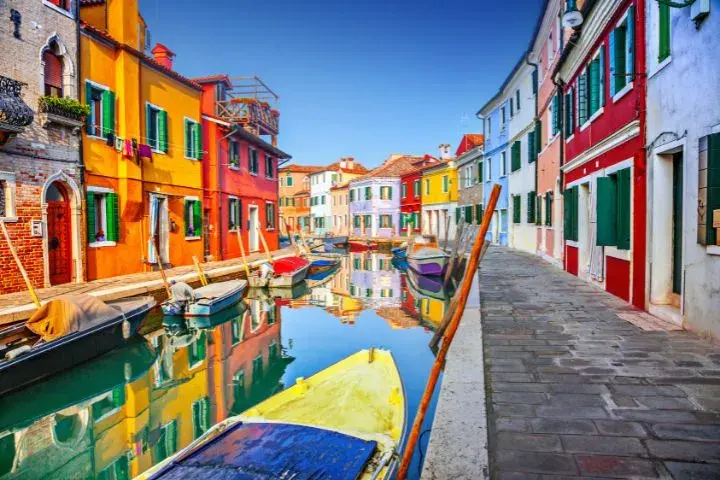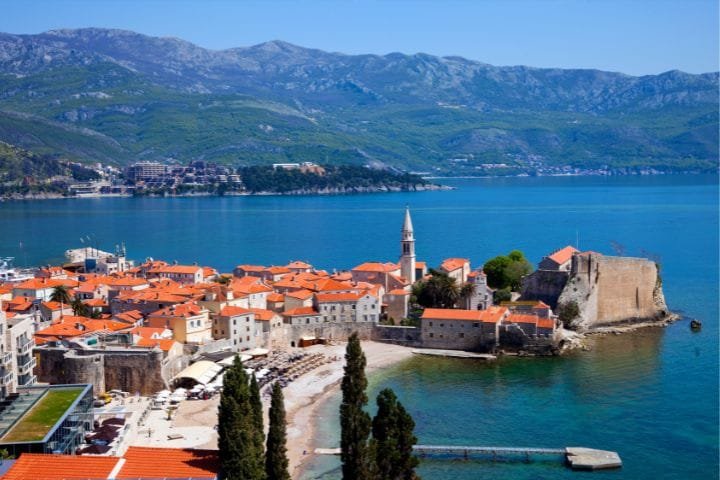6 Months to Departure: Your European Road Trip Planning Timeline

by Mary | Last Updated November 30, 2025

Planning a European road trip is like orchestrating a symphony – many moving parts need to come together at just the right time. Did you know that over 70% of European road trip troubles occur because travelers didn’t plan far enough in advance?
I’ve been there myself, applying for an International Driving Permit just two weeks before departure, sweating bullets while tracking the mail! Trust me, that’s not how you want to start your dream adventure through the winding coastal roads of the Amalfi Coast or the majestic mountain passes of the Alps.
Whether you’re dreaming of cruising through multiple countries or focusing on a specific region, breaking down your planning into a monthly timeline will transform what seems like an overwhelming project into manageable steps.
This 2025 guide will walk you through exactly what to tackle each month for your European road trip planning timeline, ensuring you’ll be fully prepared when the day comes to hit the road. Let’s turn that pin-filled map of dreams into a real-life adventure!
6 Months Before: Dream, Research, and Budget
The foundation of a successful European road trip begins with thorough research and realistic expectations. Six months before departure is the ideal time to establish your trip’s framework.
This is the fun part! Pull up Google Maps and start dropping pins on all those places you’ve been dying to see. Back in 2023, I spent a whole weekend just watching YouTube drives through the Dolomites and coastal Croatia, totally worth it!

Define Your Road Trip Vision
Start by creating a vision board or list of must-see destinations. Ask yourself:
- Which countries or regions are an absolute must-visit?
- Do you prefer coastal drives, mountain routes, or cultural city-hopping?
- Are you interested in famous routes like the Romantic Road in Germany or creating your own path?
- What experiences are non-negotiable for your trip?
This visioning process helps narrow down the overwhelming options Europe offers.
Research Optimal Seasons
Each European region shines at different times of the year:
- Mediterranean countries are often best in spring or fall to avoid extreme heat and crowds
- The Alps are spectacular in summer for hiking or winter for ski access
- Northern Europe has long, bright summer days but cold, dark winters
- Consider festival seasons that might enhance (or complicate) your journey
Research seasonal weather patterns for your target regions to identify the ideal travel window.
Establish a Realistic Budget
Create a comprehensive budget spreadsheet including the following:
- Transportation (flights to Europe, car rental/fuel, or your own vehicle costs)
- Accommodation (varying by country and setting)
- Food and dining (research country-specific costs)
- Attractions and activities
- Toll roads and vignettes
- Emergency fund (10-15% buffer)
Be realistic – European prices vary dramatically between regions, with Scandinavia and Switzerland typically being the most expensive, while Eastern Europe offers better value.

Check Passport Validity
Many European countries require passports valid for at least six months beyond your intended departure date. Check your passport’s expiration date and renew if necessary, allowing ample time for processing.
Start a Dedicated Savings Plan
Based on your budget, establish a monthly savings target. Consider:
- Setting up a separate travel savings account
- Automating transfers to this account
- Identifying areas where you can temporarily reduce expenses
- Researching credit cards with travel rewards or no foreign transaction fees
Create a Shared Planning Document
If traveling with companions, establish a shared digital workspace (Google Docs, Notion, etc.) to:
- Document ideas and preferences
- Assign research responsibilities
- Track decisions and reservations
- Keep everyone engaged in the planning process

5 Months Before: Route Planning and Documentation
Don’t freak out, but this is when the rubber meets the road – literally! Five months before departure, you get to start turning those dreamy pins into an actual route. I spent hours with coffee and Google Maps figuring out if my dream Italian coastal drive was actually doable in the time we had.
With your vision established, it’s time to start mapping out realistic routes and addressing documentation needs.
Plot Potential Routes
Begin sketching possible routes connecting your must-see destinations:
- Use Google Maps or specialized road trip planners to visualize distances
- Connect major destinations with efficient routes
- Identify scenic detours worth considering
- Research ferry connections if your route includes islands or shortcuts
Consider creating a custom Google Map where you can pin all potential stops.
Calculate Realistic Driving Times
European driving often takes longer than estimated due to:
- Narrower roads than in North America
- Mountain passes with reduced speeds
- Historic town centers with limited vehicle access
- Border crossings in non-Schengen areas
A good rule of thumb: take Google Maps driving estimates and add 25% for a more realistic timeframe.

Research Border Crossing Requirements
Identify which borders you’ll cross and research requirements:
- Schengen Area borders (usually no stops required)
- Non-Schengen European borders (passport control)
- Special requirements for rental cars crossing borders
Check Visa Requirements
If you’re not an EU citizen, research visa requirements:
- Most tourists need a Schengen visa covering most of Western Europe
- Remember the 90-day limit within a 180-day period for Schengen countries
- Separate visas may be needed for the UK, Ireland, and some Eastern European countries
Visa & Health Requirements
Please make sure you check all the information you need to know about the passport, visa, and health requirements of your destination.
Check out all the data provided by IATA (International Air Transport Association)
Begin International Driving Permit Application
Start the International Driving Permit (IDP) application process:
- Verify which type of IDP is needed for your specific destinations
- Gather necessary documentation (usually your valid driver’s license, passport photos, and application form)
- Submit an application to your country’s authorized provider
- Allow several weeks for processing
Research Seasonal Events
Identify major events that might impact your travels:
- Major festivals that could enhance your trip
- School holidays that might increase tourist crowds
- Local celebrations that could affect accommodation availability
- Sporting events that might cause road closures or accommodation scarcity
Plan Your Trip with Our Favorite Booking Tools
4 Months Before: Transportation and Accommodation Strategy
Four months out means it’s time to make some big decisions about wheels and beds! This is when you need to commit to whether you’re renting a car or bringing your own vehicle. Trust me, it’s not just about cost – each option comes with its own headaches and perks.

Decide Between Renting or Bringing Your Own Vehicle
Weigh the pros and cons of rental versus using your own car:
- Rental benefits: newer vehicle, breakdown coverage, no long-term wear on your car
- Own vehicle benefits: familiarity, no rental restrictions, potentially lower cost for longer trips
- Consider one-way rental options if you don’t plan a circular route
If bringing your own vehicle, research:
- Insurance requirements for European coverage
- Required vehicle modifications (headlight adjusters, safety equipment)
- Ferry or Eurotunnel booking if coming from the UK
Compare Rental Car Companies
If renting, research companies thoroughlyactiv:
- Compare not just prices but also:
- Cross-border policies (some restrict certain countries)
- One-way rental fees
- Additional driver charges
- Age restrictions (often higher fees for those under 25)
- Automatic vs. manual transmission availability and pricing
Request quotes from multiple providers and read the fine print carefully.
Book High-Demand Accommodations
Secure accommodations for locations that:
- Are in popular tourist areas
- Coincide with local festivals or high seasons
- Have limited options (small towns, remote areas)
- Are planned for weekend stays
Leave some flexibility in less competitive locations.
Research Different Lodging Options
Consider diverse accommodation types to enhance your experience:
- Hotels in city centers and for onvenience
- Apartment rentals for longer stays and self-catering
- B&Bs for local charm and insider knowledge
- Agriturismo (farm stays) in rural areas
- Camping for budget options and natural settings
Investigate Parking Availability
For city stays especially, research parking options:
- Hotel parking availability and costs (often significant in European cities)
- Public parking locations and rates
- Park-and-ride facilities for larger cities
- Restricted driving zones in historic centers

Consider Alternative Transportation
Plan for areas where driving isn’t ideal:
- Major cities where public transport is preferable
- Car-free destinations (Venice, Cinque Terre villages, etc.)
- Options for temporarily returning rental cars
- Train connections between major cities
3 Months Before: Practical Requirements and Insurance
The three-month mark is where things get real with paperwork and protection! This is when you need to get serious about insurance coverage and country-specific requirements. I cannot stress this enough – skimping on insurance to save a few bucks is NEVER worth it! I learned this lesson when a friend’s rental got scratched in a tiny Italian parking lot, and they faced a €1,500 deductible without proper coverage.
Secure Comprehensive Travel Insurance
Research and purchase travel insurance covering:
- Trip cancellation/interruption
- Medical emergencies and evacuation
- Lost luggage
- Rental car excess/deductible coverage
- COVID-related disruptions
Look for policies specifically designed for road trips with good vehicle-related coverage.
Arrange Vehicle Insurance
Ensure proper vehicle insurance coverage:
- For rental cars, determine whether to purchase the rental company’s coverage or use a third-party policy
- For your own vehicle: arrange a Green Card (International Insurance Certificate)
- Consider supplemental policies covering:
- Windshield damage (common on road trips)
- Tire and undercarriage damage
- Roadside assistance with repatriation coverage
Research Country-Specific Driving Requirements
Create a checklist of required items for each country you’ll visit:
- France requires warning triangles, reflective vests, and breathalyzers
- Germany requires first aid kits and warning triangles
- Many countries have specific headlight requirements
- Winter tire requirements in alpine regions during certain months

Check Environmental Zone Requirements
Research Low Emission Zones (LEZs) in cities you plan to visit:
- Many European cities restrict vehicle access based on emissions standards
- Registration or special stickers may be required (Germany’s Umweltplakette, France’s Crit’Air)
- Some historic centers prohibit non-residential vehicles entirely
Apply for any necessary permits well in advance.
Order Required Vignettes
Purchase highway vignettes (toll stickers) for countries requiring them:
- Switzerland, Austria, the Czech Republic, Slovenia, etc.
- Some can be purchased online in advance
- Others must be purchased at border crossings or gas stations
- Research digital vignette options where available
Start Organizing Documents
Create both physical and digital document organization systems:
- Purchase a dedicated travel document folder
- Scan all important documents to secure cloud storage
- Create a country-by-country checklist of required papers
- Make multiple copies of essential documents
Plan Your Trip with Our Favorite Booking Tools
2 Months Before: Detailed Itinerary and Reservations
Alright, two months to go, and it’s time to nail down those daily plans! This is when I grab my favorite travel mug, clear the kitchen table, and spread out all my notes to craft a realistic day-by-day plan.
Finalize Day-by-Day Itinerary
Create a detailed but flexible daily plan:
- Determine driving days versus exploration days
- Identify realistic driving distances (200-300 km max for sightseeing days)
- Plan morning departures for driving days to allow buffer time
- Note check-in/check-out times for all accommodations
Balance structure with flexibility for spontaneous discoveries.
Book Remaining Accommodations
Secure all outstanding accommodation reservations:
- Fill gaps in your itinerary
- Consider booking.com’s “free cancellation” options for flexibility
- Save all confirmation emails in a dedicated folder
- Add all accommodations to your shared trip document
Reserve Must-Visit Attractions
Pre-book tickets for popular attractions:
- Many major European sites now require timed entry tickets
- Look for “skip-the-line” options at major attractions
- Research city passes that might save money and time
- Schedule tours or special experiences
Download and Test Navigation Apps
Prepare your digital navigation tools:
- Google Maps (with offline download capability)
- Waze for real-time traffic (where you’ll have data)
- Country-specific apps (e.g., ViaMichelin for France)
- Consider dedicated GPS devices as backup
Test each app on similar routes to your planned drives.
Research Fuel Station Availability
Plan for refueling, especially in remote areas:
- Map major gas stations along your route
- Note differing fuel types across Europe (different diesel standards)
- Download apps like ARAL or Shell station finders
- Research payment methods (some unmanned stations only accept European chip cards)
Plan Rest Days and Buffer Time
Build flexibility into your itinerary:
- Schedule a rest day after every 3-4 days of intensive sightseeing
- Allow buffer days for unexpected delays or discoveries
- Don’t plan to depart immediately after arriving jet-lagged
- Include contingency time before any non-refundable bookings

1 Month Before: Tech Prep and Fine-Tuning
One month before departure, focus on technical preparations and final adjustments.
Arrange International Data Plans
Prepare your devices for international use:
- Research international data packages from your carrier
- Consider purchasing European SIM cards upon arrival
- Investigate pocket WiFi rental options
- Determine which devices need connectivity
Download Offline Maps
Prepare for areas with poor connectivity:
- Download Google Maps offline areas for your entire route
- Consider apps like Maps.me for comprehensive offline mapping
- Download city maps for walking navigation
- Save important locations as favorites for quick access
Create Playlists and Download Entertainment
Prepare entertainment for long drives:
- Create Spotify playlists and download them for offline use
- Download podcasts about European history and culture
- Consider audiobooks related to your destinations
- Download movies/shows for passengers on long drives
Check Weather Forecasts and Adjust
Begin monitoring seasonal trends and adjust as needed:
- Research typical weather for your travel dates
- Begin checking long-range forecasts
- Adjust packing plans based on predicted conditions
- Prepare for varying climates if crossing regions
Notify Your Bank of Travel Plans
Prevent card blocks during your trip:
- Register travel plans with all credit and debit card providers
- Note international customer service numbers
- Verify daily withdrawal/spending limits
- Confirm cards with no foreign transaction fees
Research Local Emergency Information
Prepare for unexpected situations:
- Note the European emergency number (112)
- Research country-specific emergency services
- Locate major hospitals along your route
- Save the embassy contact information
2 Weeks Before: Final Preparations
T-minus two weeks, and it’s crunch time, people! This is when my stress dreams about showing up without hotel reservations usually kick in. Take a deep breath, methodically confirm all details, and create backup plans.
Confirm All Reservations
Double-check all bookings:
- Email accommodations to reconfirm reservations
- Verify the car rental pickup location and hours
- Confirm any guided tours or special experiences
- Print or save confirmation numbers
Create a Shared Itinerary
Distribute your complete itinerary:
- Share with emergency contacts at home
- Include all accommodation addresses and contact info
- Add confirmation numbers and booking details
- Note planned driving routes
Consider using TripIt or similar apps to organize this information.
Exchange Some Currency
Prepare cash for immediate needs:
- Exchange small amounts of currency for countries that prefer cash
- Research typical cash needs by country (Germany relies more on cash than Scandinavia)
- Plan an ATM strategy for additional withdrawals
- Secure money in multiple locations (not all in one wallet/bag)
Pack a Car Emergency Kit
Assemble essentials for vehicle emergencies:
- First aid kit (required in some countries)
- Flashlight and batteries
- Basic tools
- Snacks and water
- Phone chargers and power banks
- Paper maps as backup
Recheck Driving Times
Verify your driving estimates with current conditions:
- Research ongoing road construction projects
- Check for seasonal road closures (especially in the mountains)
- Verify ferry schedules if applicable
- Account for border crossing times in non-Schengen areas
Prepare Backup Maps
Don’t rely solely on digital navigation:
- Purchase physical maps or a European road atlas
- Print key routes from online maps
- Mark alternative routes in case of closure
- Note important waypoints and services

1 Week Before: Packing and Last Checks
In the final week, focus on efficient packing and document organization.
Begin Packing Strategically
Pack with European conditions in mind:
- Layered clothing for variable weather
- Comfortable walking shoes (European cities often have cobblestones)
- Adapters for European electrical outlets
- Compact, wrinkle-resistant fabrics
- Rain gear, regardless of the season
Consider packing cubes to keep the car organized during your journey.
Gather Required Documents
Organize all documents in one secure location:
- Passport and any required visas
- Driver’s license and International Driving Permit
- Insurance documents (vehicle, health, travel)
- Vehicle registration (if bringing your own)
- Rental car confirmation
- Accommodation confirmations
- Attraction tickets and reservations
Check Prescription Medication Requirements
Prepare properly for medication needs:
- Ensure a sufficient supply for the entire trip, plus a buffer
- Keep medications in their original labeled containers
- Bring a copy of prescriptions using generic drug names
- Research any restrictions on medications in destination countries
- Pack medicines in a carry-on if flying first
Download Translation Apps
Prepare for language barriers:
- Install Google Translate with offline language packs
- Consider specialized apps like iTranslate
- Learn basic phrases in local languages
- Download visual translation apps for menus and signs
Arrange Home Security
Prepare your home for your absence:
- Arrange for mail collection or holding
- Set timers for lights
- Notify trusted neighbors
- Adjust thermostats and water heaters
- Unplug unnecessary appliances
Double-Check All Documents
Make final verification of all paperwork:
- Ensure all digital copies are accessible offline
- Verify that physical documents are organized and accessible
- Check that emergency contacts have your itinerary
- Confirm insurance coverage dates match your trip exactly
🗓️ Your 6-Month Europe Road Trip Timeline: Essential Guides to Plan Every Stage
Before diving into your month-by-month road trip preparation, make sure you explore these key planning resources that guide you through documents, packing, budgeting, and route planning from start to finish.
- Start strong with European Road Trip Planning Checklist — the complete overview of everything you need before departure.
- Get your paperwork ready using European Road Trip Documents Checklist — passports, insurance, rental paperwork, and border requirements.
- Choose the right gear with European Road Trip Technology Checklist — apps, gadgets, power essentials, and navigation tools.
- Build the perfect packing system using Essential Europe Car Travel Packing List — safety items, must-have accessories, and organization tips.
- Plan your costs in advance with Europe Fuel Cost Calculator — especially helpful for multi-country trips.
- Avoid surprise charges by reading Europe’s Highway Vignette & Toll System Guide — essential for border crossings and toll-heavy routes.
- Protect your trip investment with Best Travel Insurance for Europe Road Trippers — recommended for emergencies, medical coverage, and rental car protection.
Final Words
Planning a European road trip doesn’t have to be overwhelming when you spread the tasks across a strategic 6-month timeline. By following this month-by-month guide, you’ll not only reduce pre-trip stress but also create a more thoughtful, well-researched adventure that maximizes every moment on the road.
Remember that flexibility remains key – even the most precisely planned road trips sometimes take unexpected detours, and those unplanned moments often become favorite memories!
So pin this timeline somewhere visible, set those monthly calendar reminders, and take the first step toward your European road trip dream today. The historic villages, stunning coastlines, and mountain vistas of Europe are waiting for you – and now you know exactly how to get there!
💬 We’d love to hear from you!
Have questions, tips, or personal travel stories to share? Drop them in the comments below — your insights help fellow travelers plan their adventures too.













